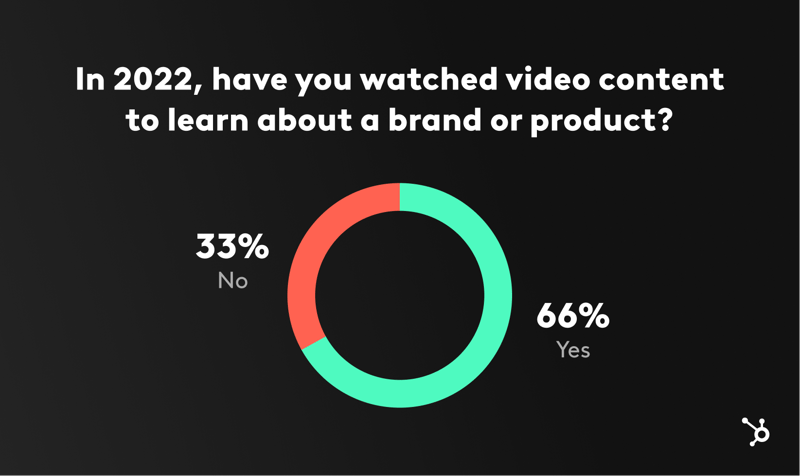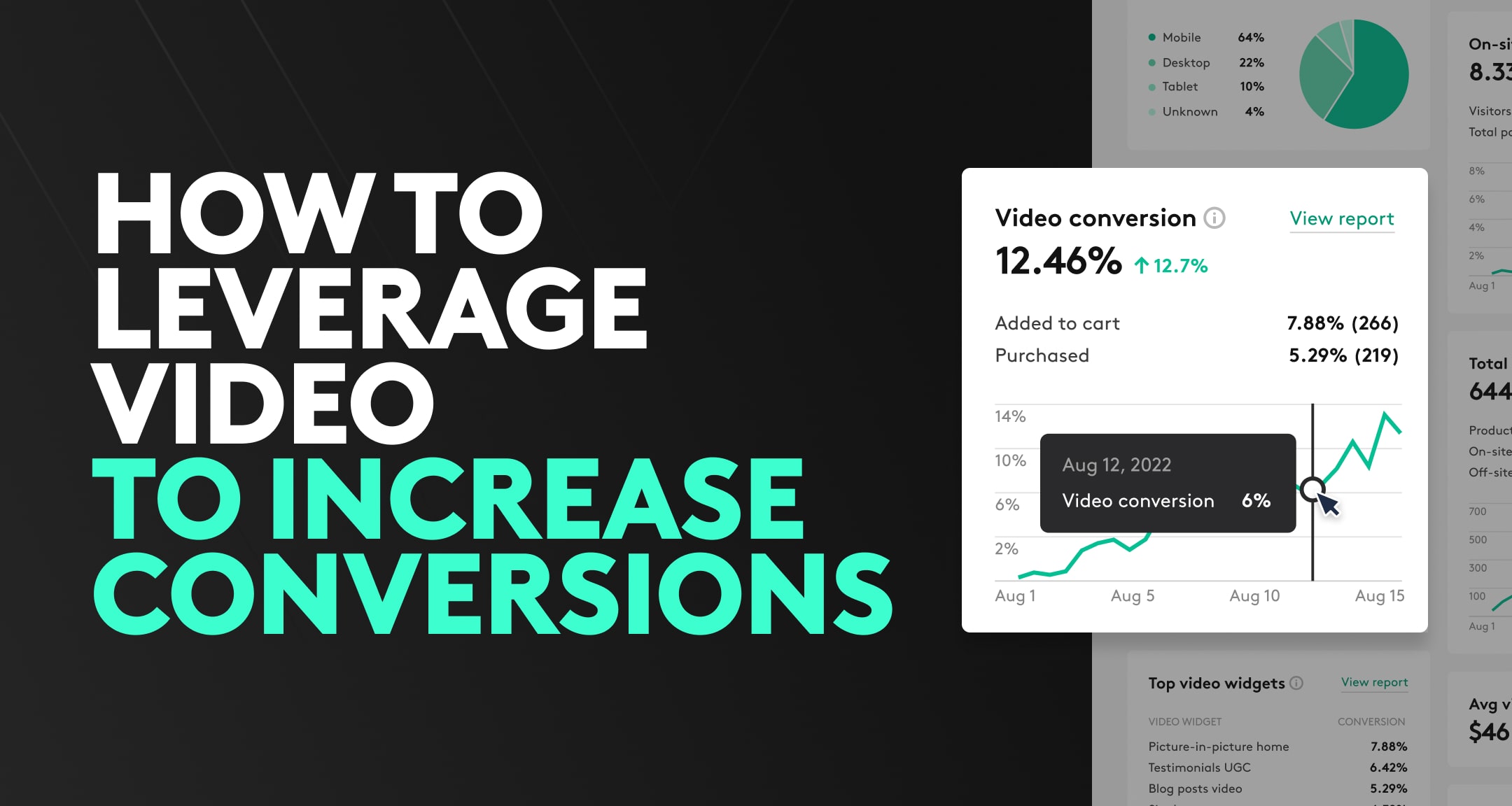Share
Ever found a product through an Instagram Reel or while scrolling TikTok and wanted to buy it? Video is one of the most immersive formats, so it’s no surprise that people are more convinced to buy that moisturizer or a new ramen flavor when they see it in a fun video.
More than 50% of internet users looked for videos related to a product or service before visiting a store.
What if they could click “Buy” right from the video? And what if that store was yours?
With shoppable videos, this is a reality! We’ll help you understand how shoppable videos work and how you can implement them on your Shopify store.
What is a shoppable video?
A shoppable video is an interactive marketing video that allows viewers to purchase products while watching the content. This video is clickable and allows instant purchasing by clicking on a call-to-action without exiting the video. The experience mimics in-store shopping without ever having to leave a social or video platform.
By making a video shoppable, you allow new visitors to purchase your products while they are fully engaged with your content.
How does a shoppable video work?
A shopper who wants to buy sunscreen may start their search on Google. Once landing on a product page, they’d watch a video on how to use this sunscreen, tips, and the final result. At the halfway mark, they may decide to buy the product. Instead of exiting the video, the shopper can instantly click the “Add to Cart” button placed within the video player and finish checkout.
Immi Eats, for instance, uses shoppable videos on its website to show how other shoppers have put their spin when cooking their ramen.
Shoppable videos don’t just exist on-site. Some of the best instances of shoppable videos are at discovery. A TikTok user might land on a video about a home decor item. If the video has shoppable capabilities, the user can click on buy and head directly to checkout.
Benefits of Shoppable Videos
46% of consumers want to watch product videos before they buy.
The journey from discovering a product to purchasing is messy for shoppers. There's usually a lot of back and forth. They need multiple searches to verify the product’s credibility, check its usefulness and value, and even compare other similar items with it.
Video solves this. Instead of wandering away to research, videos on your product pages can answer these questions for your shoppers. Add in the ability to purchase from the videos, and your shoppers can easily buy after watching them.
With videos on-site, you’ll see higher engagement and, thanks to the format, better conversions on your products. Brands have seen conversion rates as high as 18%.
Another bonus is the impact that videos have on your search ranking. With videos on your site and longer page sessions, Google will start ranking your store and product pages better. Unconventional but shoppable videos have proven to improve your SEO as well.
Want to start using shoppable videos on your Shopify store? Read how you can use VideoWise.
What types of shoppable videos can you use?
There isn't one specific kind of video that you can use. The type of shoppable videos you use for your brand depends on the information you want to convey to your shoppers.
Here are a few questions that can help you pick the right kind of video to create or source:
- What information about your product(s) is hard to convey in words but easy to explain with a video?
- What information would shoppers need to understand your product better and buy?
Based on this, you’d be able to plan your video content better. Here are eight types of videos you would end up using:
1. Video Reviews
A video review shows the product in detail, all the features it contains, and the pros and cons of the product. Shoppers can trust these videos since these reviews are objective and give honest feedback on the product.
Headphone Zone sources review videos of their products and adds them to each of their product pages to help shoppers get an honest understanding of the different headphones they sell.
2. How-to videos
Need to explain how to use your product? A how-to video is a great way to create authentic social proof and inspire trust. Incorporate videos that show how the product works, the best way to use it, and any additional features and best practices.
NOOD sells adhesive bra alternatives, a product that needs a little more than pictures to understand. The brand uses videos to explain how to apply these adhesive bras and the difference they make to your outfit.
3. Product comparison
If you have variants or products that accomplish similar needs, shoppers may be confused about which one is right for them. Shoppers would be able to make a faster decision with videos that compare these products, along with details on which one serves different needs and preferences.
Brands selling electronics, beauty products, etc., would be able to quicken purchases with these videos.
4. Detailed walkthrough
Complex products need a little more than images. You can show all your product’s features with videos, giving shoppers a complete picture.
Leesa does a great job at implementing these types of videos. They know that their products require some set-up and may be complex to understand. So, the brand created videos showing how to unbox and set up their products so shoppers can easily start using them without hiring someone to set it up.
5. Benefits
But what’s great about it? If you find your potential shoppers questioning the need for your product, you need to spell it out for them. A video can allow you to visualize and illustrate the product's benefits better.<
>Empowered by Ashley, a safety brand, uses shoppable videos to convey the benefits of its product and better educate shoppers on the different ways it helps.
Another brand that does this well is Ava Estell, an all-natural skincare brand. They’ve created videos to show their different product in use while explaining how to use them and the results that shoppers can expect from them.
6. Testimonials
Another way to build credibility is through the voice of your customers. If you have user-generated content showing customers using your product, adding them to your product pages can help you build trust and show new visitors how well-loved your products are.
Apolla is known for its performance wear made for dancers. The brand uses videos on its website to share its customers' stories and show how much they trust its products.
7. Before and after
Does your product make a marked difference in your shoppers, their lives, or an existing item they use? With a before and after video, you can better communicate what difference your product makes to the shopper and give them visual proof of it.
CAMSKNS sells camera customization kits. The brand uses videos to show the before and after of using their customization kits and how shoppers can elevate their cameras using them.
Where can you use shoppable videos?
To put it simply? Almost everywhere you communicate with your shoppers. You can leverage this format within your Shopify store, add them within your outbound marketing strategy, and even on social media platforms.
Let's explore how they would improve your sales on each of these platforms and how you can use them efficiently:
Adding shoppable videos on-site
You can place these interactive videos across your Shopify store, guiding shoppers from different products to checkout.
Make sure to source or upload the relevant videos (based on what would help your shoppers trust you and be convinced to buy) and place them at different touchpoints on-site. Not sure where you should put these videos? Look at your user journey and heatmaps to identify where shoppers may drop off at your store.
For instance, shoppers may drop off at the end of the product page or the product description section, right after the images. Based on your evaluation, you'd know where your shoppable videos would be most visible and helpful..
Add shoppable functionality to your videos with Videowise. Using the Shopify app, add videos to your pages, customize their appearance, and add CTAs to allow checkout within the video player.
Within outbound marketing
An exciting promotion via email or SMS usually drives your shoppers to your product page. This standardized method isn't always convincing, and you may lose interest. Instead, you can provide shoppers with a more immersive experience by taking them to a video campaign.
So, rather than reading through the product page, shoppers can get an explanation of your product through an engaging video. They can shop the item while viewing the video or look at other similar ones.
By making shoppable video campaigns part of your outbound marketing strategy (via email or SMS), you could keep shoppers just as engaged as they were when they clicked on your promotion and maintain it long enough to convert them.
Driving upsells via product packaging
One of the best times to upsell your products is right after purchase. The best place? Right on your product packaging.
Add a QR code to your packaging, taking customers to a shoppable video recommending products that pair well with their purchase. For instance, a hair care brand can add a QR code to their shampoo box that takes customers to videos on hair creams and gels that suit the customer’s hair type.
Leveraging shoppable videos on off-site platforms
From native posts to ads, social commerce tools on Facebook, Instagram, TikTok, and Pinterest empower brands to promote to their target audience and effectively sell on social media.
Scrolling through Instagram, shoppers may land on a post that subtly promotes the brand's products. They can effortlessly swipe or click through to the product page, learn more about it and ultimately, buy.
How do you make a video shoppable?
Social media platforms provide you with the ability to make your videos shoppable. Shoppers can click on the catalog listing and be directed to the product page to finish purchasing.
However, for native videos within your Shopify store and videos from your outbound marketing campaigns, you can use Videowise. The Shopify app lets shoppers add to their cart directly within the video. When setting it up, you can customize every aspect of the shopping experience— from the preview widget and the video player to even the “Add to Cart” button.
How is Shoppable Video Shaping the Future of Retail?
Video is the most consumed form of media today. The increase in video consumption has made even tech giants completely change their approach. Instagram, for instance, is the most prominent example. Once a photo-sharing platform, it now majorly features videos across the platform.
Source: Hubspot
Videos are a way for consumers to “window shop” while they spend time online. This is great news for anyone selling online. But besides learning more about a brand, consumers also use videos to get more information during their buying journey. Once they've gotten this information, being able to buy (and quickly) is the next significant factor.
That's why it's crucial to use video and make them shoppable, adapting to this change in how people shop.
Ready to convert your shoppers better?
Shoppable video is a goldmine of opportunity for brands. Use it within your site for smoother conversions, upsell after purchasing on the product packaging, and increase discoverability on social media— the possibilities are vast, and the results speak for themselves.
See how brands like Apolla and Ava Estell use Videowise. And if you’re ready to leverage this immersive format for your brand, you can install Videowise on your Shopify store now!
Share




.jpg?width=420&height=420&name=live%20shopping%20top%205%20fashion%20(1).jpg)